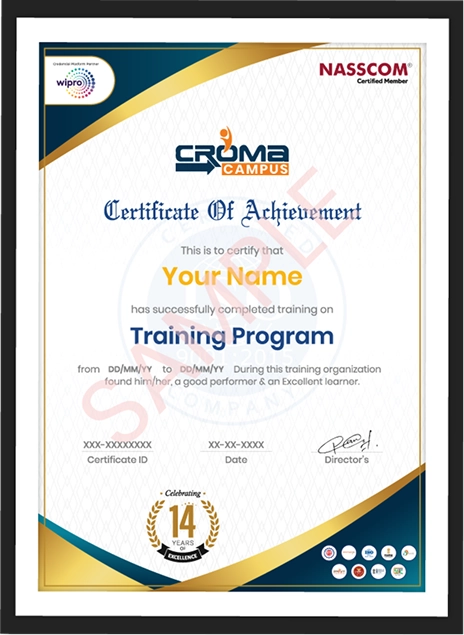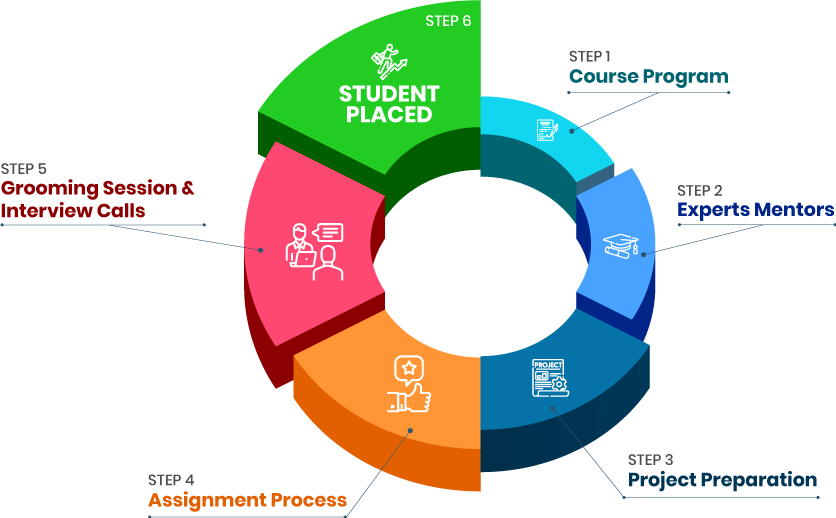Course Design By
Nasscom & Wipro
The course has been design by top industry practitioners to help you establish yourself as a certified IoT professional and earn more.
Get to know IoT basics, IoT architecture, IoT decision framework, and more.
With the IoT training institute in Noida, know how to configure raspberry Pi, know about programming sensors, actuators, and more.
Understand more about IoT networking protocols and learn how to design more powerful solutions than usual.
Know about cloud or Azure IoT hub, and how to demonstrate hub APIs in MS azure.
With the top IoT training institute in Noida, learn to design end-to-end solutions using various IoT technologies and tools as needed by the business.
You could learn about performing data analytics techniques on to the collected data and use prediction algorithms to get meaningful insights from it.
It is estimated that more than 50 billion devices will be based on IoT by 2022.
The global market will reach up to 2 trillion from 700 billion by the end of 2022.
According to Glassdoor, your basic salary would be $150K as an IoT developer, and you could earn more as a certified and experienced professional.
There will be a time when IoT will be used everywhere and it will increase number of job options for you in an exponential way.
With more than 30 billion devices powered by IoT, there is a huge demand of trained and certified IoT experts who could manage their workloads effectively.
With the leading IoT training institute in Noida, you could prepare yourself for global certification in IoT and grow like a superstar in the IT industry.
Get 100% placement assistance, build an impressive resume that is difficult to reject by anyone and get hired.
It minimizes the risk of thunderstorm by leveraging maximum data analytics capabilities. It also helps in saving millions of dollars and other cost cutting too.
The IoT implementation helps in achieving maximum customer satisfaction by logistics and operations management among industries.
According to IDC, there will be a huge demand of IoT things in the near future. So, take your IoT placement course now and get hired right away.
You must have the depth idea of the basic and advanced concepts in IoT.
You must know IoT basics, IoT architecture, IoT decision framework, and more.
You should know how to configure raspberry Pi, know about programming sensors, actuators, and more.
You should have a depth idea of IoT networking protocols and learn how to design more powerful solutions than usual.
You must know about cloud or Azure IoT hub, and how to demonstrate hub APIs in MS azure.
You must know how to design end-to-end solutions using various IoT technologies and tools as needed by the business.
You must know about performing data analytics techniques on to the collected data and use prediction algorithms to get meaningful insights from it.
we train you to get hired.

By registering here, I agree to Croma Campus Terms & Conditions and Privacy Policy
+ More Lessons
Course Design By
Nasscom & Wipro
Course Offered By
Croma Campus
Stories
success
inspiration
career upgrade
career upgrade
career upgrade
career upgrade
You will get certificate after
completion of program
You will get certificate after
completion of program
You will get certificate after
completion of program
in Collaboration with

Empowering Learning Through Real Experiences and Innovation
we train you to get hired.
Phone (For Voice Call):
+91-971 152 6942WhatsApp (For Call & Chat):
+91-971 152 6942Get a peek through the entire curriculum designed that ensures Placement Guidance
Course Design By
Course Offered By
Ready to streamline Your Process? Submit Your batch request today!
Furthermore, Croma Campus is the well-known (Internet of Things) IOT training with high tech infrastructure & lab facilities. IOT Course in Noida by 15+ years experienced real time expert. Croma Campus is the main IoT Training institute and trained more than 500+ Students. Our IOT Training is totally centered to get placement in MNC.
Things are becoming smart nowadays and autonomous also. IOT devices don’t need human intervention. The cameras on the road are automatic they don’t need and human things, sensors and microcontroller So it creates maximum jobs in good MNCs.
Croma Campus is the well-known IOT training institute and also provides the certification. We also provide access to servers so that candidates will implement the projects at home easily. More than 3000+ candidates are mentored by the Croma campus and got certification from us.
Croma Campus is a well-equipped iOS Training Center. Candidates will implement the following concepts under iOS – Understanding of iOS platform, iOS Application Life Cycle, Understanding of X-Code IDE, How to installed X-Code Environment, Integration of SQLite into Apps, Basics of XML Structure, SQLite Database, Core Data, Basic UITabbar application, Creation UITabbar Controller, Using Interface Builder, Facebook Integration, Twitter Integration, Linked-In Integration, Google Plus Integration, Run Simple Queries, How to configure the database, on real-time projects along with iOS Placement Training modules like aptitude test preparation, etc.
The ways to connect Croma Campus. Phone number: - +91-120-4155255, +91-9711526942
Address: - G-21, Sector-03, Noida (201301) Email: - info@cromacampus.com

Highest Salary Offered
Average Salary Hike
Placed in MNC’s
Year’s in Training

fast-tracked into managerial careers.
Get inspired by their progress in the
Career Growth Report.
FOR QUERIES, FEEDBACK OR ASSISTANCE
Best of support with us
For Voice Call
+91-971 152 6942For Whatsapp Call & Chat
+91-9711526942




















